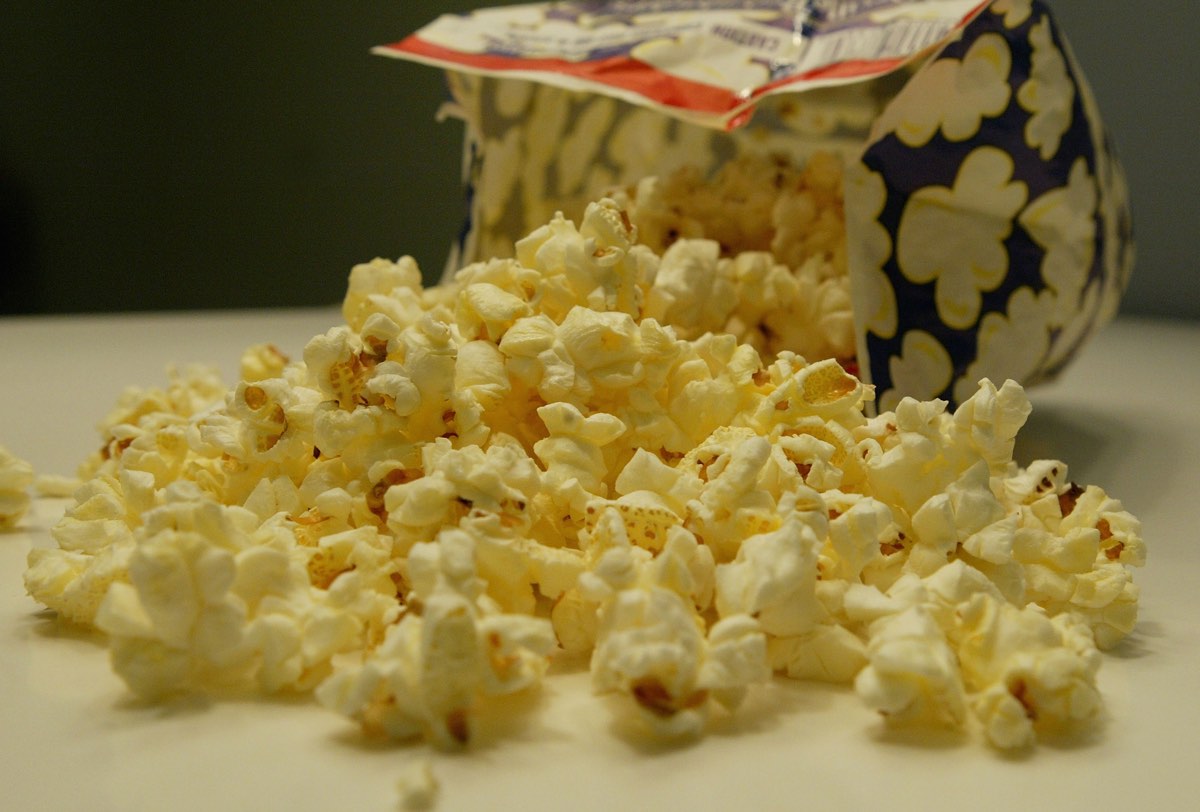
Why Does Microwave Popcorn Smell So Bad?

We've all experienced it. You walk into your kitchen or your office breakroom, and the smell assails you: savory, buttery, toasty. Someone's been microwaving popcorn. Yum — or ick, depending on your sensitivity.
Google searches for the smell of microwave popcorn lead to threads that mention all kinds of odors, from buttery heaven to vomit to urine. (More accurately, it smells like a bearcat's butt, scientists say.)
Love it or hate it, the smell of microwave popcorn is distinct. So, what's the chemical behind the aroma? In most cases, it's one of several artificial flavorings known for their oily, buttery vibe. These flavorings have occasionally appeared in the news, mentioned as health threats, but there isn't evidence that they hurt the casual popcorn-popper; they instead pose a danger, according to the National Institute for Occupational Safety and Health (NIOSH), to workers who inhale them in large quantities at facilities where microwave popcorn is made. [9 Snack Foods: Healthy or Not?]
Hidden damage
One of the most common flavorings in popcorn is a compound called diacetyl. In foods like butter and sour cream, diacetyl occurs naturally as a byproduct of fermentation, and it imparts that creamy, buttery flavor so desired in these foods. For its use as a food additive, diacetyl is made by removing hydrogen from another substance, 2,3-butanediol.
Diacetyl became a subject of health concerns in the early 2000s, when researchers published findings from a microwave popcorn plant where eight former workers came down with severe obstructive lung disease. Diacetyl was one of the most prominent contaminants in the plant's air. That finding led to an array of animal and epidemiological studies that found that, sure enough, the substance can damage the cells lining the lungs and trachea. The resulting condition is called obliterative bronchiolitis, and it produces inflammation and scarring that can be bad enough to require a lung transplant, according to the Centers for Disease Control and Prevention.
In 2007, several popcorn manufacturers — including ConAgra Foods Inc., General Mills Inc. and the American Pop Corn Company — said they were phasing diacetyl out of their products, according to Associated Press reports at the time. However, a 2016 study in the journal Toxicologic Pathology using rats found that the replacement chemicals they used — 2,3-pentanedione and 2,3-hexanedione — could also cause lung damage.
There is no evidence that these compounds cause damage for people popping popcorn before movie night at home, however, the researchers wrote.
Sign up for the Live Science daily newsletter now
Get the world’s most fascinating discoveries delivered straight to your inbox.
Both diacetyl and pentanedione are reactive compounds, and their reactivity comes from the same active chemical group, called a dicarbonyl group, said Ann Hubbs, a researcher at NIOSH who has studied the substances. The only difference between the two compounds, Hubbs told Live Science, is that diacetyl is a four-carbon compound, while pentanedione boasts five carbon molecules. When these compounds come into contact with the lining of the respiratory system, they damage proteins in the airways.
The chemicals react especially readily with an amino acid (a protein building block) called arginine, Hubbs said. The result of such reactions, sometimes known as "popcorn lung," is irreversible damage to the tiny alveoli where air exchange occurs in the lungs.
What's that smell?
Microwave popcorn's smell is distinctive, but you might catch a whiff of it in other odd places. The binturong, or bearcat, a Southeast Asian mammal, is famous — as far as Southeast Asian mammals go — for smelling like buttered popcorn. That's because another compound that gives microwave popcorn its smell also appears in the urine of the binturong.
A 2016 study in the journal The Science of Nature found that binturong urine is chock-full of a compound called 2-acetyl-1-pyrroline. This substance forms during the Maillard reaction, or the browning reaction that occurs when sugars or amino acids are heated. (Like crusty bread? Thank the Maillard reaction.)
In popcorn, 2-acetyl-1-pyrroline gives off a toasted smell as the sugars in the kernels heat. This compound is also found in foods like white bread and jasmine rice. The binturong or bearcat uses the substance for scent-marking.
The Duke researchers who discovered the compound in binturong pee also found that it was one of the few compounds in the animals' urine that smelled stronger with time, perhaps explaining why your microwave reeks for days after movie night. There's even at least one blog with tips for removing the popcorn stink from your microwave.
(Binturongs probably produce the compound in cooperation with microbes living near their urinary tract or anal glands, according to the Duke researchers.)
If your own pee starts smelling like popcorn, though, you might want to pay attention. According to Healthline, a health information site written by doctors, popcorn-smelling pee could be a harmless side effect of eating or drinking something that contains a large amount of compounds called ketones (diacetyl is a ketone, but other types of ketones are found in all sorts of foods). Or the smell could be a sign that your body is excreting too many ketones on its own, a possible symptom of diabetes.
Original article on Live Science.

Stephanie Pappas is a contributing writer for Live Science, covering topics ranging from geoscience to archaeology to the human brain and behavior. She was previously a senior writer for Live Science but is now a freelancer based in Denver, Colorado, and regularly contributes to Scientific American and The Monitor, the monthly magazine of the American Psychological Association. Stephanie received a bachelor's degree in psychology from the University of South Carolina and a graduate certificate in science communication from the University of California, Santa Cruz.










